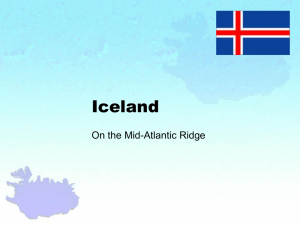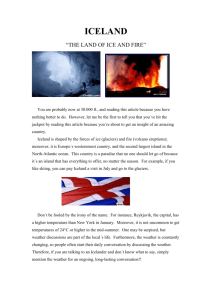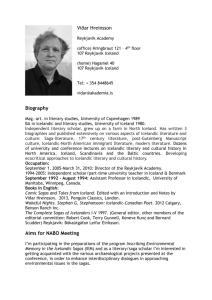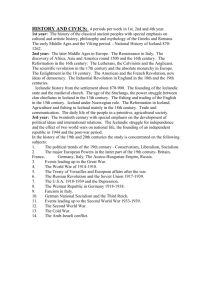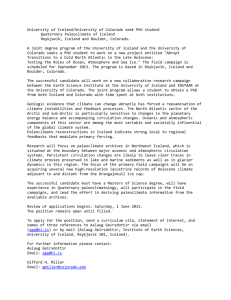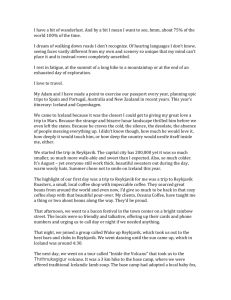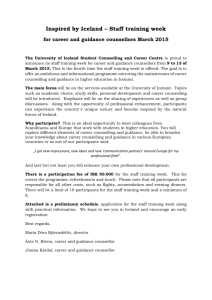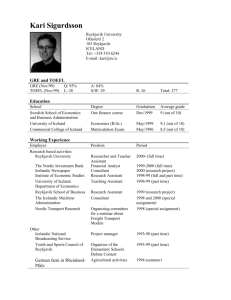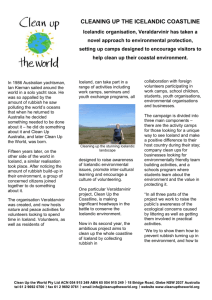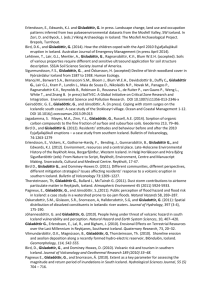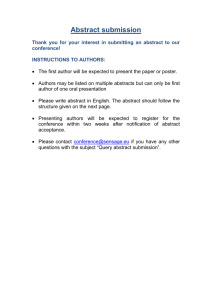Concerning the programme, the following topics should be addressed:
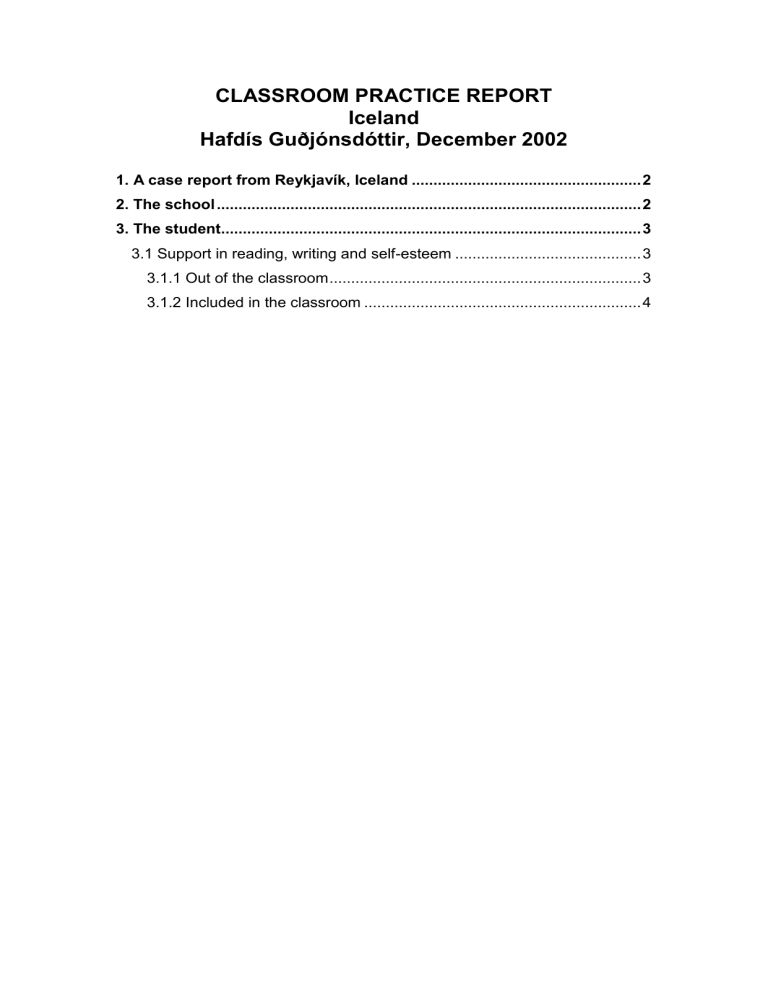
CLASSROOM PRACTICE REPORT
Iceland
Hafdís Guðjónsdóttir, December 2002
1. A case report from Reykjavík, Iceland ..................................................... 2
3.1 Support in reading, writing and self-esteem ........................................... 3
3.1.2 Included in the classroom ................................................................ 4
1. A case study from Reykjavik, Iceland
The Reykjavik Education Service (RES) has a newly established policy for special needs education. The policy for special education builds on theories of inclusive schooling and practices where each school provides services for all students with or without disabilities. To meet students’ needs in general classrooms the RES recommends that schools provide alternative teaching methods and co-operative teaching, differentiate instruction for all students, use multi-level tasks and projects, and create an individual curriculum for students with special needs. The policy builds on the law for compulsory education, regulation for special education, the state curriculum and the
Salamanca report from 1994.
The way the special education in Reykjavik is funded is also being developed and changed this year. The RES selected certain schools to become experimental schools during this time. The report does not focus on one of these schools; instead it focuses on a very typical school in a newly organised neighbourhood.
2. The school
The case study pertains to the practice in a newly established (1998) mainstream school in Reykjavik. It is a compulsory school with 380 students from age six to fourteen in 21 classrooms. There are 31 teachers and 30 other staff members. The teachers are young and their experience is limited, but their enthusiasm is enormous. The school mission is to base the teaching on the development and needs of each student as well as on the state curriculum. The school emphasises enhancing the learning environment and using multiple teaching methods. It is very important to the school personal to have a positive relationship with the students, and that students are responsible and independent in their learning behaviour. In addition, family collaboration is also of great importance to the school.
A special educator has organised the special education service in the school.
This year, in which the special educator is on a study leave, an experienced teacher stepped in to plan the service and work on individual curricula. In collaboration with the classroom teacher the individual curriculum is created.
The programmes offered in the school are both in- and out of class support.
Students can receive up to five class hours of out of classroom support each week. Support inside of the classroom, is offered in the form of a personal support, adapting instructions, study materials, expectations and the outcome.
The school also creates programmes according to the need of different individuals and these programmes can differ from year to year. We will introduce one of them in this case study. This year there is no qualified special educator and therefore there are general teachers that organise the special education service at the school. On the other hand, the principal has qualification in special education and supports the teachers when necessary.
2
Classroom Practice Country Report
Iceland
3. The student
The student in this example is a 12 years old girl who is included in a general classroom. She has learning difficulties in language and mathematics. She was diagnosed as dyslexic and with severe language delay. The student who is Icelandic was brought up in a foreign country, but moved to Iceland around the time she started school. She learned two languages at the same time in her first years. Educators thought the delay of the language development was due to this and diagnosed it as late. She is very quiet and relaxed. She becomes attached to certain persons, teachers and students and it takes her a long time to get used to others. This year has been challenging because the special educator who worked well with her last year is on a study leave and it has taken some time for her to get used to other teachers and staff members.
The student has achieved the technical part of reading and manages quite well, but she has difficulties in understanding what she is reading. Her reading skills improved greatly last school year, but when she was back to school after summer vacation she had lost some of these skills. Now three months later she has regained the skills she had last spring.
3.1 Support in reading, writing and self-esteem
She receives part of the teaching according to an individual plan both in and out of her classroom. The plan focuses on language, mathematics and selfesteem. A team that includes the general classroom teacher, special educator teacher, support teacher, and the family creates an individual educational plan. The teachers and the family evaluate the plan regularly. The classroom is heterogeneous as most, if not all, classrooms at this level in Iceland. The student spends most of the time in the classroom with modified tasks.
3.1.1 Out of the classroom
She receives three class hours out of the room to work on her language/Icelandic. These teaching hours are individual teaching and learning that focuses on her needs completely. This year the focus is on practising the reading skills, especially the reading pace. At the same time teachers are worried about her reading comprehension.
She receives support in Mathematics from her classroom teacher, where she works in another class for two hours each week on her own. This has turned out to be a quiet and supportive time, but independent work. During mathematics lessons she works with similar material as other students but adapted and modified e.g. fewer examples than other students. The teacher reports that she manages to keep up with the other students in Mathematics but she believes that is because she receives support out of the classroom, where she can catch up with the other students.
Overlapping is practised in the woodwork class where the main goal is gaining self-esteem through hands on activities and creative work for one class hour per week. The student attends the class along with two other classmates.
According to her classroom teacher this out of class support has been very effective and she believes that improvement is based on that.
3
Classroom Practice Country Report
Iceland
3.1.2 Included in the classroom
Although the student spends most of her school time included in the classroom a big part of the classroom teaching and learning organisation is individual teaching and learning. The student mostly works on her own tasks or projects during language art/Icelandic and mathematics. The tasks and work in the classroom is differentiated both in mathematics and language.
This has to do with the material, teaching strategies and outcome. Her study material is adapted and modified to her needs. At the moment she is practising her writing. One of her tasks is to use talking balloons to write discussions between different persons. The goal for this task is to construct sentences and through the use of the talking balloons the text can be short, which she can manage quite well. This is one example of teaching her to write.
The homework she works on is also completely adapted to her needs. The use of computers for her learning is great and many different programmes are used. In some cases material and books that have been turned into computer programmes are used because the teachers have found them to be more successful for her than paper versions.
Classroom Practice Country Report
Iceland
4

